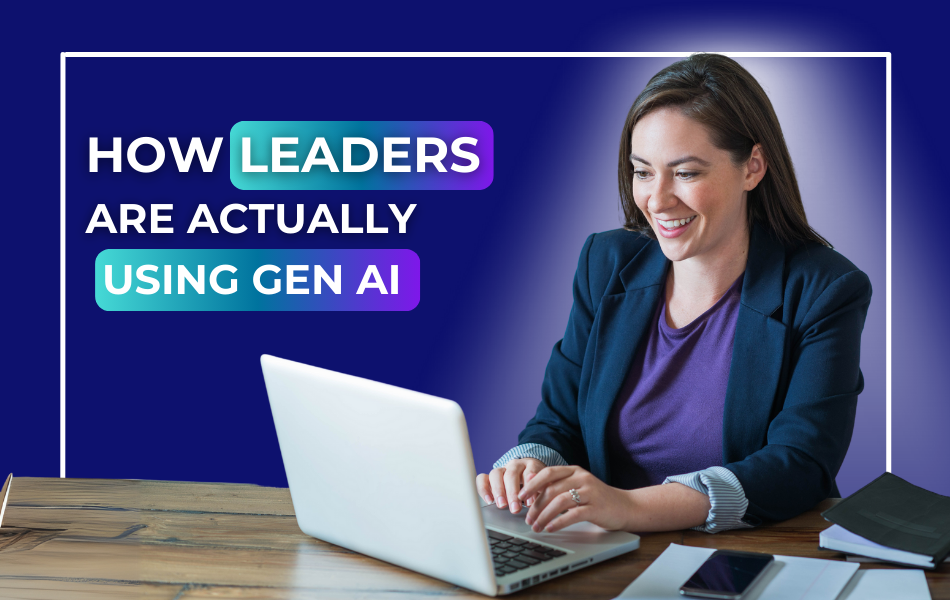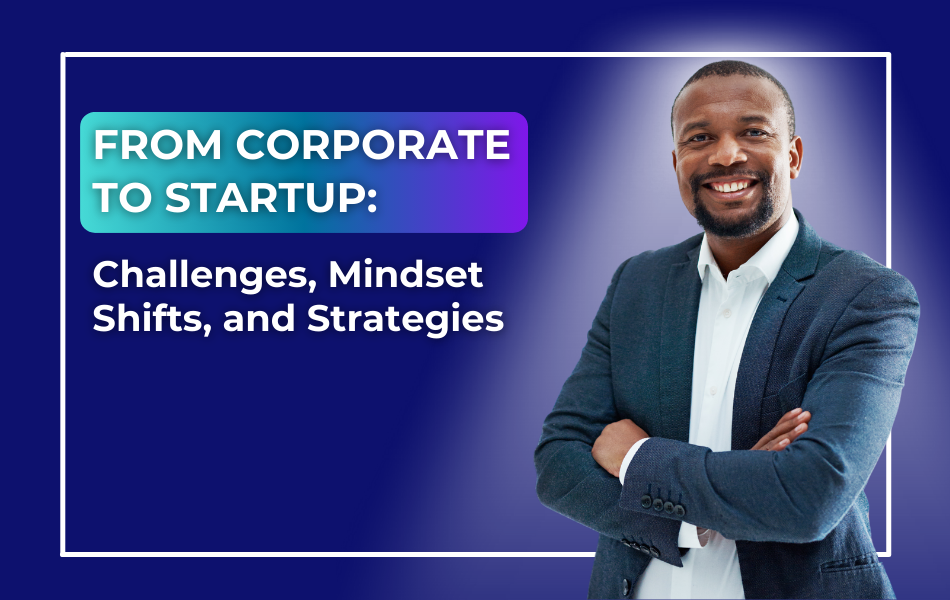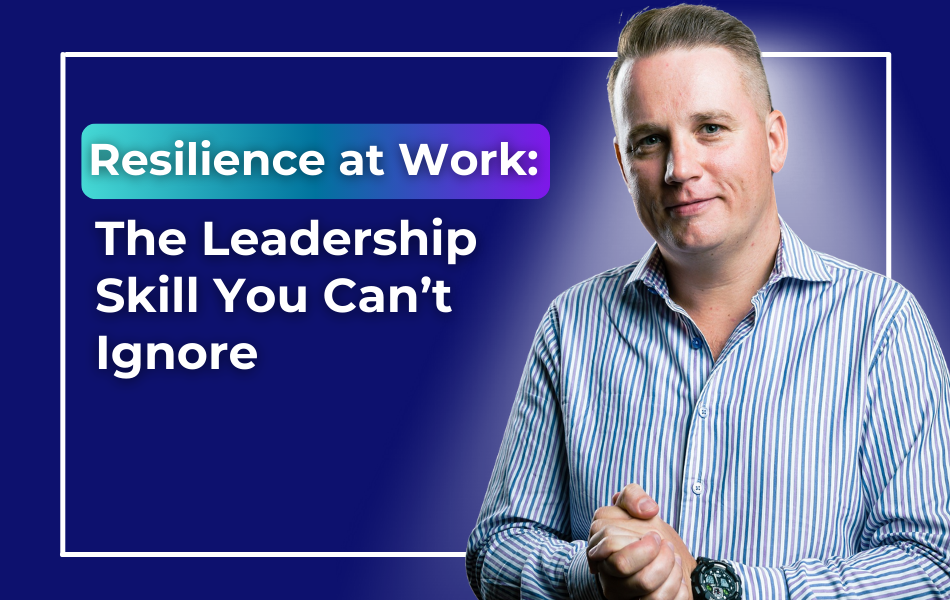
261. How Leaders Are Actually Using AI Today
How Leaders Are Actually Using AI Today
About this Episode
Ep. 261 – Let’s be honest… keeping up with AI can be a bit of a pain.
New modules dropping left and right, your inbox flooded with “groundbreaking” updates, and somehow you’re supposed to figure out how to actually use this stuff when your calendar is already packed back-to-back.
We hear this all the time from leaders like you who are just trying to keep their heads above water.
In this episode of The Manager Track Podcast, Ramona lays out concrete, low-lift ways managers are pairing Gen AI with their daily work – from faster decisions to smoother one-on-ones.
Inside, you’ll hear:
✅ What “chat fluency” is
✅ Three underused AI moves
✅ Why basic curiosity plus AI can lift leadership performance
This is a practical episode with real-life examples. No fluff! It gives you quick wins you can test before the day ends.
Listen now on our Spotify, Apple Podcasts, or YouTube.
Episode 261 Transcript:
0:00:00 – (Ramona Shaw): In this episode, we’re going to talk again about the use of Gen AI for leaders in their leadership role. Specifically, it’s been a while since we last talked about it, and it’s time to have another catch up. Here are the two questions this podcast answers. One, how do you successfully transition into your first official leadership role? And two, how do you keep climbing that leadership ladder and continuously get promoted? Although the competition and the expectations get bigger, this show, The Manager Track Podcast, will provide the answers.
0:00:30 – (Ramona Shaw): I’m your host, Ramona Shaw. I’m on a mission to create workplaces where work is seen as a source of contribution, connection and personal fulfillment. And this transition starts with developing a new generation of leaders who know how to lead.
0:00:43 – (Ramona Shaw): So everyone wins and grows.
0:00:46 – (Ramona Shaw): In the show, you’ll learn how to think, communicate, and act as a confident and competent leader you know you can be welcome to The Manager Track podcast. Today we’re going to talk about something that’s on my mind all the time. It’s the use of AI. And it’s not that AI will replace leaders or I’m not worried about AI replacing my job, and hence that’s why it’s on my mind. But it is on my mind because the way that AI influences our work, specifically Gen AI, is going to change how we work and what we look for in other people and how we manage our teams.
0:01:25 – (Ramona Shaw): And right now it seems that a lot of leaders don’t feel the implications quite yet. There’s still a lot of the technical knowledge that they need on the job and still a lot that they do manually. Expectations haven’t really changed, so their need to change the way that they do work can’t really be felt yet. But my prediction is that that will change and that will probably change sooner than many of us think.
0:01:53 – (Ramona Shaw): Leaders who are using or will be using AI in so many different aspects of their work will outperform leaders who do not use it, who still operate with the mindset of the past and the processes that worked in the past. And that whole paradigm will shift. And in fact, I’m not trying to scare anyone and saying you have to level up, otherwise you’re going to lose your job. Now, what I’m actually emphasizing is this is a huge opportunity. We can actually, as leaders be so much more impactful and change the way not only that we work and what we produce, but what our entire team produces and how we’re engaging as a team with Chen AI.
0:02:40 – (Ramona Shaw): So, as you know, as a leadership trainer, facilitator, executive coach, I talk to leaders every week, every single day. And so I want to talk about this gap that I’m seeing that I just alluded to. Most people, including you know, that AI is a big deal intellectually. We know that, we’ve seen the news, we’ve heard about it plenty of times, we’ve experimented with it, we see the hype of AI, but yet at the same time, there’s still a pretty massive difference between knowing about AI and experimenting with it and actually using it in your day to day leadership work.
0:03:25 – (Ramona Shaw): Not as a one off or ever so often, but as a fully integrated tool that you use very specifically and very effectively in the way that you operate. And so what I find is companies actually provide these tools. They offer subscriptions or the access to Gemini or ChatGPT or you name it, but yet these powerful applications are often just sitting there, not being used to its potential at all. So that disconnect between knowing about it and being fully aware and actually doing it and integrating is still pretty stark. And that leaves a huge untapped opportunity on the table.
0:04:07 – (Ramona Shaw): And it’s also exactly what I want to talk about today. The real practical AI opportunities that could may be making your leadership life easier right now, not far in the future when you have more tools and ATI and who knows what. No, the tools and approaches you could literally start using this afternoon, this evening, whatever time of the day you’re listening to this. So let’s jump in and talk about some of these practical examples.
0:04:36 – (Ramona Shaw): Because ultimately, knowing how to leverage AI for your leadership and for your team will become a core leadership competency, if it isn’t already. In fact, thinking about people are currently being hired into organizations. A lot of them are using their or testing AI skills and competencies. And I wouldn’t be surprised at all if you look at research that comes out on an annual basis that tests and does a pulse check on what are companies looking for as they hire and train leaders.
0:05:08 – (Ramona Shaw): That AI competency is going to make it into the top five, if not the number one skill within the next few years. It is not to say that emotional intelligence and technical competence aren’t valuable, it’s just that all of that can be augmented with AI, which also means anyone who has basic skills can significantly augment what they’re now able to produce. And in fact, when we look at who’s going to benefit from AI the most, it is the people who have some basic understanding, good ways of thinking who are incredibly curious to learn new skills and adaptable to those, but also curious to ask the right questions and experiment with the tools.
0:05:56 – (Ramona Shaw): They even if they don’t have a lot of experience in the field or the profession, even if they didn’t go to the best schools and didn’t get the certificates and the trainings, those people are actually having the highest upside potential from it. So if you’re over here and you’re making a 10% increase, you’re going to find yourself sort of on the same level soon with someone over here who’s from a technical standpoint and they’re training and experience lower but because of their use of AI and how they engage with it and how they incorporate it that now suddenly operating up here.
0:06:30 – (Ramona Shaw): So the what you’re going to be compared against the measuring stick. The benchmark is now changing and I think it’s a really good thing. We can change the benchmark to actually say we could do a lot better, we could bring our quality up. There’s very little reason why we now have typos in emails and that comes from someone who has on and off had a challenge with that. I’m just not as detail oriented as I sometimes wished I would be. And when things got to go fast I suddenly find a typo in my email. Typos should really no longer be a thing.
0:07:03 – (Ramona Shaw): Delivering a report that misses a key theme because you didn’t think of it should no longer be a thing. When you present something, not being prepared to handle objections that might come from the prospect or a third party should no longer be a thing. When we use AI effectively, we can really level up the quality that we’re expecting from us and from our team. And hence we’re pushing up that benchmark to what good Nile looks like alongside with other people who are going to get up there soon too.
0:07:37 – (Ramona Shaw): So a lot said here but the good news in all of this is you don’t need to become a coder or an AI expert or be really technical and savvy in this. What really matters is knowing how to think with AI and how to collaborate with it effectively and how to systemize the use of IT and to bring along the whole team so that there is a somewhat consistent or at least shared understanding and use of AI. So here are a few practices that I’m seeing most forward thinking leaders adopt.
0:08:13 – (Ramona Shaw): First is their chat fluency. So basically getting comfortable having back and forth conversations with AI tools, not just saying like hey, I need to write an email to a client who’s been waiting on a deliverable for two days and is getting upset. Please provide me A draft, that’s a one way conversation, that’s not a chat, right? That’s you prompting it to do something and, and then you kind of see what comes out of it and you like it or you don’t.
0:08:42 – (Ramona Shaw): This skill of chat fluency is really about being able to engage with it in a dialogue and iterate with it and you have an understanding of which different gen AI tools actually give the best results for what purpose? And then do you know how to engage with them and how to prompt you to give you something useful back? And then even if it’s not useful yet, do you know how to fine tune it? Do you know how to get options and to engage with it and to have it iterate and to have it update and all of that. So that is the chat fluency.
0:09:13 – (Ramona Shaw): Now the second skill is actually building your own prompt library. This is literally a document, a notion page, some kind of place that you have digitalized where you save your best AI prompts and they are well organized. This may include things such as decision making, frameworks, strategic work, how you prepare for one on ones, crafting, feedback up, leveling your communication skills, and the list goes on.
0:09:41 – (Ramona Shaw): Whatever you do repeatedly, are you training the AI tool that you’re using and do you have a library of prompts that work well for you, that you iterate on to improve over time? So that’s the second one. The third one is to use it to learn. So not to wait for the organization to provide some kind of AI course that would drop in your lap, although that would be nice, but to actually start using it when real needs come up and even if it’s going to take you longer at the end, before you jump into work, are you going to pause for a second and think, how can I leverage AI for this particular specific task most effectively?
0:10:26 – (Ramona Shaw): Do you need to draft an important email, use AI? Do you need to plan for your quarterly goals, Think about AI, do you need to do research and you’re looking for sources or do a competitive analysis in which which parts of that can be supported with AI? So the leaders who are sort of pulling ahead here with this aren’t the ones with AI degrees or particularly technical. They’re the ones who are actually just rolling up their sleeve and are starting to experiment.
0:10:53 – (Ramona Shaw): So they become sort of chat fluent, they are documenting their most effective prompts or workflows and they continuously take a step back and ask themselves in what I’m doing, how could I use it? How could I use it more effectively? What is it I haven’t experimented with or practiced with. Let me give this a shot. Those are the three things that I notice in leaders who are doing this really well. They’ve evolved in all three of them.
0:11:19 – (Ramona Shaw): Now I’m going to get a little bit more specific. I want to share three AI use cases that I’m seeing massively underused, but that can be total game changers for you as a leader. First one, using AI for smarter, faster decision making. Let’s say, for example, you are a product leader and you are planning a major feature release with a ton of stakeholders and you have a lot of competing priorities along the way.
0:11:43 – (Ramona Shaw): Instead of just going with your gut or past experiences or whatever the company has always done in the past, you could now use AI to model different release scenarios. What might happen if you prioritize certain features over others? What are potential risks for each approach? What are the different rollout strategies, and what are the implications of these different strategies on resources or product reputation?
0:12:10 – (Ramona Shaw): So literally you can create an almost a virtual advisory board through this process. With an AI tool that allows you to scenario, plan and to think through this. When you do, you’ll be able to make better informed decisions. And you already have material prepared to talk to stakeholders about the rollout and pros and cons and what to bear in mind and so forth, including the the sales perspective, the engineering perspective, the customer success angle, and all of that. It’s not that I will make the decision for you, but it’s for you to expand your thinking and to surface considerations that you might have missed and to help you prepare for future conversations that you’re going to have human to human in that scenario. It could also easily happen that the AI tool actually would help you spot a critical dependency that you would have maybe overlooked or cost you a major headache down the road because you were so in the weeds of things that you forgot to consider this one important aspect or one important dependency.
0:13:16 – (Ramona Shaw): And so AI might ask a question or may make a comment that then you think, oh my gosh, did not think of that. So glad I had like a second set of eyes who objectively went through my plan and then was able to point out what I might be missing. And yet so many leaders are making big decisions solely on their own perspective and literally an AI tool is right in front of them, just waiting there to be used.
0:13:43 – (Ramona Shaw): And it’s such a massive opportunity cost.
0:13:45 – (Ramona Shaw): As a leader, understanding and harnessing the power of AI is not just an advantage anymore, it’s becoming a necessity if you want to rise in your organization and you have 5, 10, 20 more years to go.
0:14:02 – (Ramona Shaw): There will be no way around but.
0:14:04 – (Ramona Shaw): To get involved and to embrace AI as a way to achieve business objectives. And that applies to the vast majority of departments and professionals. And if you’re in a role where you think yes, this is likely going to impact me too, get started and download our Chennai Quick Start Guide for Leaders. You will not only learn more about AI as a technology, but more importantly will address how it’s going to impact you as a leader, what skill sets you’ll want to develop in order to be well equipped during this time and ultimately become AI fluent and AI savvy. This is an easy way to get started.
0:14:45 – (Ramona Shaw): Familiarize yourself with the concepts, learn some practical tools and frameworks to leverage it right now in your role as a manager. Head on over to arcova.org free toolkits or check out the show notes or.
0:15:00 – (Ramona Shaw): Captions for the link. We’ll see you over there. The second one that I want to call out here in terms of specific use case is in people development and communication. If you’re leading a team any size, you know how much mental energy goes into the communication. You feel like you’re constantly talking upward, talking downwards, translating, getting everyone on the same page. You’re always repeating what’s happening, what isn’t happening and it’s a lot of communication.
0:15:25 – (Ramona Shaw): There are also the one on ones, the performance reviews, a lot of the coaching feedback sessions and it can add up fast. And those who have those conversations, well they’re usually the ones who, you know, take a quick beat before they type something up. They make sure they’re not emotionally reactive to things. They were well prepared for the conversations. But as nice as that sounds, it all just takes a whole lot of time.
0:15:48 – (Ramona Shaw): So let’s imagine you have 25 people reporting into you in an organization and now you start using AI to create personalized coaching prompts or to help you refine how you communicate with someone. You might quickly notice how much easier it is to get through to people now. It takes some upfront work for an AI tool to understand the different dynamics, personality types, how to communicate to someone. But it’s not all manual work.
0:16:17 – (Ramona Shaw): Assuming that you have access and from a security confidentiality and and just sort of ethical perspective. You’re allowed to transcribe meetings oftentimes now companies transcribe literally every single meeting by default for note taking purposes. You have a one on one conversation with a direct report. You take a few of those transcripts, let’s say three, four, transcripts. You feed that into a custom project or a custom ChatGPT just for that person.
0:16:44 – (Ramona Shaw): It will then learn how to speak with that person based on the transcript of your interactions. And it will likely also recall information through memory features that will help you keep things in mind that maybe because of all the million things you’re thinking about, you have in the past forgotten. So it can serve as a way to improve your communication and as a way to remind you of big themes, big topics, things that are going on.
0:17:10 – (Ramona Shaw): If this sounds like a lot of work, it really isn’t. It just takes a moment to step back, map out what you want to experiment with, what you want to try out, putting into place and leveraging so much of the resources that are already there, so much of the PDF documents and files that we have, and again the transcripts and notes and all of that and feeding it into the right tools. By the way, I forgot to mention that past performance reviews, professional development goals, or just work goals that they have, all that could be fed in and then you could ask it and say, hey, what are some important topics to bring up in our one on one goals to check in on?
0:17:48 – (Ramona Shaw): What should I pay attention to that becomes your new routine to be well prepared for those one on ones versus trying to rely on your own notes or on your memory. If that approach works for you with 25 people through different structures reporting into you, kudos to you. Now I want to call out. This is not about replacing your own thinking. You’re not delegating the thinking component to someone else or to an AI tool.
0:18:15 – (Ramona Shaw): You can’t check out and not actually be engaged. It’s all about augmenting and uplifting and saving time in such interactions. Another use case I want to quickly highlight is to prepare for difficult conversations. So if you have something that you feel like you need to say, let’s say you want to give feedback to your boss because you feel your boss is micromanaging you. How do you do that? How do you give your boss feedback that you feel micromanaged or that you feel they don’t respect you or they don’t trust you? That’s kind of tough things to say, especially if you don’t have a long lasting trusted relationship.
0:18:51 – (Ramona Shaw): You can ask an AI tool to role play and help you prepare with that. Write down what you want to say and how you feel about this. Side note, yes, you can and often should add what actually bothers you. That internal conflict is helpful to those tools to understand where you’re coming from and then providing an appropriate response. So instead of saying, help me create an outline on how to give my manager feedback that they’re micromanaging, say something such as, hey, I’m nervous about giving feedback to my boss. I don’t feel like we have a great relationship at the time. I want to bring something up that’s difficult for me to share.
0:19:30 – (Ramona Shaw): And though important because I think it’s, it’s really critical for us to work this through in our relationship and address it. Let them know how you feel. It’s going to make the output of what it brings back to you stronger and it will resonate more and will feel more authentic than if you’re just very scripted, treating it as if it was a Google search bar. In addition, you could use AI to do research to give you more sources for whatever you’re trying to to learn about.
0:19:56 – (Ramona Shaw): You can have it create talking points for team meetings. You can build in those tools for consistent workflows such as quality checks, answering customer emails, check ins, and so forth. Leaders carry a very heavy mental and emotional load, and communications I said earlier is one of those pretty heavy weights that don’t necessarily show up on a to do list. Are also maybe not the big items that are going to be assessed in your performance review. Sure, people are going to assess how well you communicate, how clearly and transparently and how frequently you communicate, how strong your relationships are, what the retention and engagement is on your team, sort of those outcomes.
0:20:37 – (Ramona Shaw): But a lot of the nuanced work isn’t really that. It’s how are you driving results? Did you achieve the objectives that the company set for your team or for your department? And so you want to use AI to really help you focus on those big pillars, those big rocks, to ensure that you’re doing well in those other components without spending unnecessary hours on it. When you do have tools at your fingertips that will make this easier and would improve your quality.
0:21:07 – (Ramona Shaw): Oh, and as I’m talking, the list of use cases keeps going on from how you write and report writing, developing a strategy for your team, analyzing data, finding patterns, and so much more. As a leader, you’re constantly consuming and producing information. It might be industry reports that you consume, board decks that you create, strategy documents that you read, internal communication and so forth. So instead of trying to memorize all this information, you can create a database with it and then use a tool such as Notebook LLM or a custom project where you upload these resources and then you can quickly engage with them without having to memorize them or trying to figure out where they’re saved on a drive.
0:21:52 – (Ramona Shaw): And again, I really want to highlight that if you’re in a leadership position, you you’re not just doing this for yourself and your personal output. You’re really doing this to elevate your entire team to role model it, but also to set up prompt libraries for your team to have the dialogue and how are we using it and how do we build it into our different workflows to have shared documents with ideas?
0:22:14 – (Ramona Shaw): This saves everyone from reinventing the wheel. So now ask yourself for a moment, what’s that one thing for you and what’s the first step that you’re going to do within the next couple couple of days? If all this sounds good, but beyond that initial step of what to do next seems a bit overwhelming, or you’re just generally curious to learn more about how to leverage AI in your particular situation, then head down to the show notes and click the link to schedule a strategy call.
0:22:39 – (Ramona Shaw): In that call, we can talk about what specifically you’re looking for and how we at archova can support you with those initiatives and goals. And with that, that’s a wrap for our conversation today. Not only because we are at the end of our topics that I wanted to share with you today, but also because the camera died. And if you watch this on YouTube, you might have noticed what is up with this background? Where did Ramona go? Well, that’s the reason for it, but I will be back on screen in our next episode of The Manager Track podcast. Bye for now.
0:23:12 – (Ramona Shaw): If you enjoyed this episode, then check out two other awesome resources to help you become a leader people love to work with. This includes a free masterclass class on how to successfully lead as a new manager. Check it out @archova.org/masterclass the second resource is my best selling book the Confident and competent New Manager. How to quickly rise to success in your first leadership role. Check it out @archova.org/
0:23:40 – (Ramona Shaw): books or head on over to Amazon and grab your copy there. You can find all those links in the show notes down below.
REFLECTION & DISCUSSION QUESTIONS
- Which task today could AI cut in half?
- Where would a quick AI chat sharpen your last email?
- What looming decision will you test-drive with AI first?
RESOURCES MENTIONED
- Grab the free New Manager Toolkit mentioned in the episode: archova.org/freetoolkits
- Learn how to turn your 1-on-1 meetings from time wasters, awkward moments, status updates, or non-existent into your most important and valuable meeting with your directs all week. Learn more at: ArchovaVideo Course: Effective 1-on-1 Meetings – ArchovaVideo Course: Effective 1-on-1 Meetings – Archovaarchova.org/1on1-course
- Schedule a Leadership Strategy Call with Ramona HERE.
- Grab your copy of Ramona’s best-selling book ‘The Confident & Competent New Manager: How to Rapidly Rise to Success in Your First Leadership Role’: amzn.to/3TuOdcP
OTHER EPISODES YOU MIGHT LIKE
- Episode 240 – AI-Powered People Leadership
- Episode 218 –GenAI for Managers
WHAT’S NEXT?
Learn more about our leadership development programs, coaching, and workshops at archova.org.
Grab your copy of Ramona’s best-selling book ‘The Confident & Competent New Manager: How to Rapidly Rise to Success in Your First Leadership Role’: amzn.to/3TuOdcP
If this episode inspired you in some way, take a screenshot of you listening on your device and post it to your Instagram Stories, and tag me @ramona.shaw.leadership or DM me on LinkedIn at linkedin.com/in/ramona-shaw
Are you in your first manager role and don’t want to mess it up? Watch our FREE Masterclass and discover the 4 shifts to become a leader people love to work for: www.archova.org/masterclass
Don’t forget to invest time each week to increase your self-awareness, celebrate your wins, and learn from your mistakes. Your career grows only to the extent that you grow. Grab your Career Journal with leadership exercises and weekly reflections here: ramonashaw.com/shop
Love the podcast and haven’t left a review yet? All you have to do is go to ramonashaw.com/itunes and to our Spotify, and give your honest review. Thanks for your support of this show!
* Disclaimer: Shownotes may contain affiliate links. That means that I am awarded a small commission for purchases made through them, at no added cost to you.






